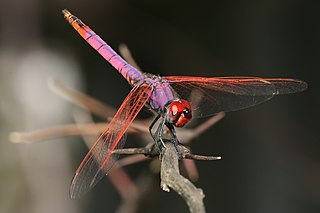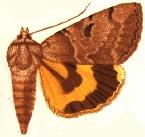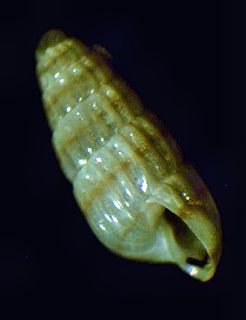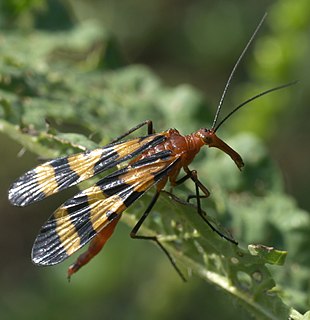
The yellow crazy ant(Anoplolepis gracilipes), also known as the long-legged ant or Maldive ant, is a species of ant, thought to be native to West Africa or Asia. They have been accidentally introduced to numerous places in the world's tropics.

A species that is extinct in the wild (EW) is one that has been categorized by the International Union for Conservation of Nature as known only by living members kept in captivity or as a naturalized population outside its historic range due to massive habitat loss.
Nephelomys keaysi, also known as Keays's oryzomys or Keays's rice rat, is a species of rodent in the genus Nephelomys of family Cricetidae. It is found from southeastern Peru to northern Bolivia on the eastern slope of the Andes in Yungas humid forest at altitudes of 1000 to 2600 m. Although its continued existence is not in serious danger and it is listed as "least concern", destruction of its habitat may pose a threat to some populations.

The Christmas boobook, also known more specifically as the Christmas Island hawk-owl, is a species of owl in the family Strigidae.

The Christmas white-eye is a species of bird in the family Zosteropidae. It is endemic to Christmas Island. Its natural habitats are tropical and subtropical moist broadleaf forests and subtropical or tropical moist shrubland. It is threatened by habitat destruction.

Thestor brachycerus, the Knysna skolly, is a species of butterfly in the family Lycaenidae. It is endemic to South Africa.
Thestor yildizae, the peninsula skolly, is a species of butterfly in the family Lycaenidae. It is endemic to South Africa, where it is only found on the high slopes of the Cape Peninsula Mountains in the Western Cape.

Anoplolepis, also known as the "pugnacious ants", is a genus of ants in the subfamily Formicinae and tribe Lasiini. The genus is mainly found in the Afrotropics, with a few native species known from the Malagasy and Oriental regions.

Trithemis is a genus of dragonflies in the family Libellulidae. They are commonly known as dropwings. There are over 40 species, mainly from Africa; two are endemic to Madagascar, and five can be found in Asia. They are found in a wide variety of habitats; some species being adapted to permanent streams in forests, and others being capable of breeding in temporary pools in deserts.
Trithemis nuptialis is a species of dragonfly in the family Libellulidae. It is found in Angola, Cameroon, Central African Republic, the Republic of the Congo, the Democratic Republic of the Congo, Ivory Coast, Equatorial Guinea, Gabon, Guinea, Liberia, Niger, Nigeria, Sierra Leone, Tanzania, Uganda, and Zambia. Its natural habitats are subtropical or tropical moist lowland forests and rivers.

The Christmas Island shrew, also known as the Christmas Island musk-shrew is an extremely rare or possibly extinct shrew from Christmas Island. It was variously placed as subspecies of the Asian gray shrew or the Southeast Asian shrew, but morphological differences and the large distance between the species indicate that it is an entirely distinct species.

Catocala nuptialis, the married underwing, is a moth of the family Erebidae. The species was first described by Francis Walker in 1858. It is found in North America from Manitoba south through Minnesota and Nebraska to eastern Oklahoma and Texas and east to Kentucky and Illinois.

Anoplolepis custodiens, commonly known as the common pugnacious ant, is a species of ant in the genus Anoplolepis, native to central and southern Africa. Individual ants may come in a range of colors and sizes. Found in dry and cultivated areas, it is an important source of prey for some pangolins and aardvarks. Although generally aggressive, ants from other colonies of Anoplolepis custodiens are not attacked.
Thestor pictus, the Langeberg skolly, is a butterfly of the family Lycaenidae. It is found in South Africa, where it is found in fynbos-covered mountain slopes above Garcia's Pass on the Langeberg.
Thestor rileyi, the Riley's skolly, is a butterfly of the family Lycaenidae. It is found in South Africa, where it is known from the Western Cape, from the Helderberg and Paarl mountains to the Kouebokkeveldberg, Piketberg and Paardeberg mountain ranges.

Odostomella is a genus of sea snails, marine gastropod mollusks in the family Pyramidellidae, the pyrams and their allies.

The Seychelles frog is a species of frog endemic to Mahé, Silhouette and Praslin islands in the Seychelles. It inhabits the floor of damp rainforest at altitudes from 150 m (490 ft) to 991 m (3,251 ft) above sea level. Higher altitude sites are considered to be more climatically stable and more suitable. The species is present in Morne Seychellois National Park, Silhouette National Park and Praslin National Park.

Panorpa nuptialis is a species of common scorpionfly in the family Panorpidae. It is also found in North America.

The Gau iguana is a species of iguana endemic to Gau Island in the Fijian archipelago. It mostly lives in the well-preserved upland forests of the island, with smaller populations in the degraded coastal forests. It can be distinguished from other South Pacific iguanas by the male's distinctive color pattern and solid green throat. It is also the smallest of all South Pacific iguanas, being about 13% smaller than the third smallest species and 40% smaller than the largest extant species.












